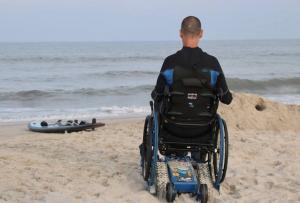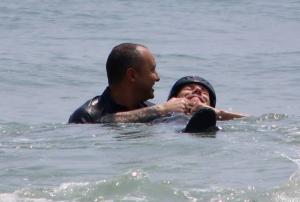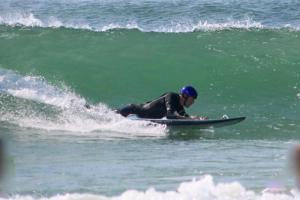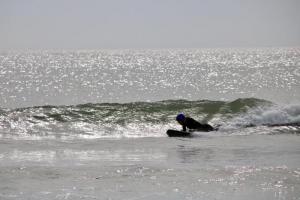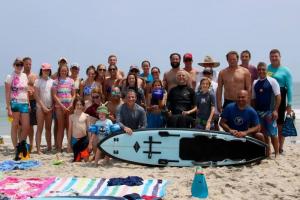Surfer Jay Liesener takes control of a body that’s controlled him for decades
Adaptive athlete Jay Liesener said telling his parents was the hardest part of making the decision to choose quality of life over quantity.
“It’s a horrifying experience to tell your parents they’re going to outlive their son,” he said during a lunch at The Backyard in Milton, acknowledging the choice will ultimately lead to his hastened death.
Melanie, Liesener’s unwavering wife, quickly chimes in.
“They’re still proud. He’s living his life with dignity, and he’s able to take control of his own destiny,” she said.
Readers of the Cape Gazette will recognize the 45-year-old Liesener – this Milton resident’s inspirational story has been told many times, including a Saltwater Portrait and an athlete of the week.
Liesener suffered a C4 and C5 spinal injury when he was 17 years old and has been living in a wheelchair, with limited arm movement, ever since. Twelve years ago, he had to give up his career as a college professor, the wear and tear on his body taking a toll. Ten years ago, a buddy modified a surfboard to fit his body and, with the help of a small group of friends, Liesener, a longtime surfing fanboy, set out to do what he thought was impossible – surf.
Liesener does most of his surfing at the northside of the Indian River Inlet or Assateague Island National Seashore in Maryland, but he went to Puerto Rico in April and has been to the Outer Banks a number of times. Four years ago his inspirational story won him a trip to Hawaii to surf with the most famous big wave riders in the world.
Liesener and Melanie get a healthy chuckle at a comparison with big wave surfers, but there is one undeniable similarity – the call of the crested wave, no matter the size, is too loud to ignore. When big wave legends Eddie Aikau or Mark Foo took to the water, they knew it could be the last time they went out and eventually it caught up to them. The waves Liesener rides aren’t likely to be big enough to kill him, but one day it will catch up to him too. It’s death by a thousand waves, and it’s something he’s come to grips with.
“This is the last opportunity I have to live the life I want to live, instead of dying in a hospital,” he said.
Melanie understands. “This didn’t come out of the blue. It’s been so challenging for him to be isolated,” she said.
Over the years, the design of Liesener’s surfboard has been modified, the wave riding has gotten better, and the group of friends known affectionately as Team Surfgimp has grown, but Liesener’s nonsurfing life has also gotten harder. This past fall and winter, after a summer of saltwater and sun, he spent five straight months in bed, prisoner of a body that is simply taking longer and longer to recover.
The problem, Liesener said, is that his body is healing and deteriorating. The sores he develops from his active lifestyle require bed rest to heal, but after lying in bed so long his muscle strength is nonexistent.
“When I got up I was too weak to push my wheelchair. It hurt to hold my head up,” he said. “I was trying to keep my strength with my bands, but there’s all these other muscles that just weren’t getting any work.”
Liesener said the turning point in choosing quality over quantity came this spring. Specialist after specialist said the only option was to stay in bed.
Melanie said doctors kept saying they’ve got plenty of patients who live full and happy lives living in bed full time, but they’re 80 or 90 years old. She snorted, shook her head and took another bite of her sandwich.
Liesener said he’s got no desire to live the next 40 or 45 years in bed.
“That’s not a quality of life I wish on anybody,” he said.
In many ways, said Liesener, a great weight has been lifted off his shoulders since he began sharing his plan to enjoy life to the fullest.
“I don’t have to ask if I’m getting out of bed. I know I’m getting up tomorrow,” he said.
Many of Liesener’s friends had known about his decision for months, but he made it public with a July 11 post on the Team Surfgimp Facebook page. Melanie posts photos from each surf session, and Liesener said it was important to him to get the message out while people could still say goodbye. Facebook is a version of life that is rose-tinted, he said.
“Everybody has shown overwhelming support,” said Liesener, who is currently living with sores that in the past would have laid him up. “I was really afraid people would think that I had just given up. I’ve always tried to have a certain amount of integrity, and I was afraid people might think I wasn’t living up to the expectations I’ve set for myself.”
Liesener’s friends didn’t just show emotional support when news of his decision started to spread – the Facebook page documents the many people who’ve rallied around a friend – they also showed monetary support.
In five days, with no media attention, more than $15,000 was raised through crowd funding so he could cross another wish off his list – surfing in southern California. The money, he said, is being spent on getting his team out west. To date, 21 people have signed up. Liesener and Melanie are paying their own way.
“If you surf, you’ve got to go to southern California at least once,” he said, a stoked smile spreading across his face as he thinks of the week-long trip coming in mid-August.
Liesener said he’s humbled by the support he’s received over the past couple of weeks. It was a complete surprise, he said.
“I would have been satisfied if donations of $10 or $20 had trickled in, and quite frankly that is what I expected,” he said. “It is hard to put words to the gratitude that I feel toward everyone who has supported this effort.”
Liesener will attempt to show that gratitude during a send-off party Thursday, Aug. 3, at the Big Chill Beach Club on the southside of the Indian River Inlet. The details are still up in the air, but there’s something happening, he said with a flying-by-the-seat-of-our-pants laugh.
When Liesener, Melanie and the team return from California, there’s no timeframe for how much longer he’ll be able to continue surfing locally.
In the past, said Melanie, when he’s gotten sick, it happens quickly.
Liesener said the fundraising goal for his specific cause has been met, but there are still ways people can help. He encourages supporting organizations that introduce people with disabilities to the ocean and surfing, such as Life Rolls On, Access Surf and Coastal Adaptive Sports.
Liesener said following his death, he’s hoping Team Surfgimp will live on, helping to support others in similar situations. There’s all the equipment and it’s become a way of life for a whole bunch of people, he said.
“It would be meaningful for me to know this has kept going,” he said. “It would be my way of leaving something behind for the world.”
Chris Flood has been working for the Cape Gazette since early 2014. He currently covers Rehoboth Beach and Henlopen Acres, but has also covered Dewey Beach and the state government. He covers environmental stories, business stories and random stories on subjects he finds interesting, and he also writes a column called Choppin’ Wood that runs every other week. He’s a graduate of the University of Maine and the Landing School of Boat Building & Design.














